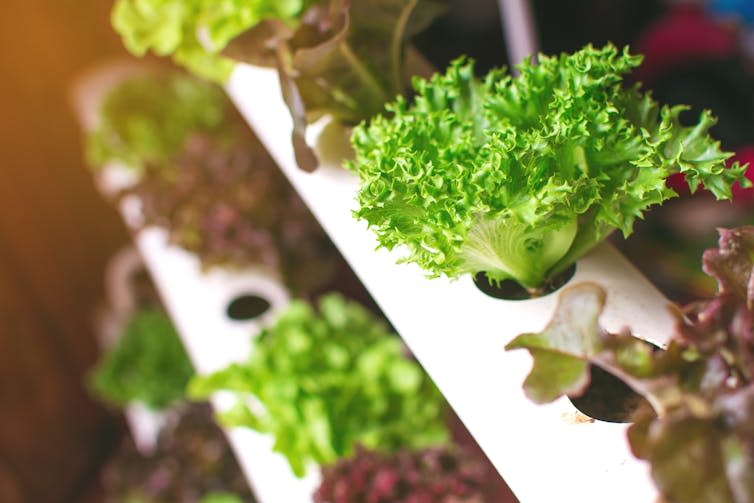Vertical farms look high-tech and sophisticated, but the basics are simple – plants are grown without soil, with their roots in a nutrient-rich solution. This innovative approach to agriculture is growing in global market value and is expected to reach US$23.23 billion (£18.55 billion) by 2029.
Usually, this soilless cultivation takes place in greenhouses or huge warehouses, with plants stacked high on rows and rows of shelves. Computer systems can control parameters such as lighting, temperature and humidity, so vertical farming is sometimes called controlled environment agriculture.
There are three types of vertical farming. In hydroponics, plant roots are kept in a liquid nutrient solution. In aeroponics, roots are exposed to air and a nutrient-rich mist or spray is applied to the roots. In the aquarium, nutrients from fish farm waste replace some or all of the chemical fertilizers delivered to plants via hydroponics.
There is huge scope for producing a lot of food using these farming methods but there are four main myths about vertical farming that need to be debunked:
1. Vertical farms will have a huge impact
Some may worry that vertical farming threatens traditional field farming, but this could not be further from the truth. Currently, it is profitable to grow only a limited range of small, fast-growing and high-value plants such as lettuce and leafy greens in this way.
It is expected that vertical farming costs will fall due to economies of scale and standardization of processes, so a wider range of crops could be grown. But there is an ethical issue to consider: just because something can be grown this way doesn’t mean it should be. Vertical farming of grain crops, such as wheat, is technically possible but requires so much energy that it is not cost-effective.
Although vertical farming uses land efficiently – by stacking, it fits more crops per unit area – it cannot compete with the scale of food production required globally. It is a complementary method of food production, which can increase food production and resilience within UK supply chains. Growing lettuce on vertical farms reduces the need to import lettuce from overseas, reduces food miles and reduces dependence on overseas field production that may be vulnerable to drought.

Vertical farms can support traditional agriculture by providing space to develop new crop types or to grow the planting of young trees and crops that are later planted in the fields. By freeing up significant areas of land, vertical farming provides space for other food production, bioenergy plans or reforestation and ecosystem restoration. It can improve traditional farming, but it will never replace it.
2. Vertical farming will benefit everyone
While this is a nice idea, it is not currently a reality. Most vertically grown crops are sold at a premium. Simple economics means that because the product costs more to make, it must sell for a higher price. Vertical farms have a high capital expenditure due to the infrastructure required: climate controlled grow rooms, soilless systems, lighting, heating, cooling and ventilation. They are energy intensive, even if they are run on renewable sources such as photos. Their operating expenses are also high due to the energy costs of running systems and the need for more highly skilled workers.
Some researchers suggest that urban-based vertical farms can help combat nutritional food deserts. This may be true, because they produce food close to consumers, but to increase this costs must be reduced. The innovative Robin Hood business model – charging the rich more and giving discounts to the less fortunate for the same product – could provide equal access for everyone in urban areas.
3. Vertical farming is not sustainable
This argument usually stems from the fact that vertical farms require electricity to run. They do, but a decarbonised grid that runs on 100% renewable energy makes a huge difference to this point. Many commercial vertical farms are already getting their electricity from renewable energy providers. Traditional crop field production also has associated emissions, using diesel tractors and so on.
In some ways vertical farming can be more sustainable than field production. It is a closed loop recirculating system which means that water and fertilizer are reused frequently. There is no runoff into the environment, unlike farming – as any excess agricultural chemicals run off the crops if there is rain and end up in the soil, groundwater or rivers.
Many of the UK’s leafy greens are currently grown overseas in water stressed areas and require irrigation which exacerbates any water shortage. Field agriculture uses huge amounts of herbicides (weed killers) and pesticides (chemicals that kill insect pests). The controlled environment of vertical farms reduces or eliminates the need for these synthetic chemicals. If pests become an issue on vertical farms, natural predators such as ladybugs can be introduced to kill aphids.
4. Vertical farming is not natural
Naturalness is subjective. Basically vertical farming uses technology to mimic processes and environments found in nature. It does not manipulate or challenge natural processes.


In field cultivation, crops grow in the soil and use the Sun for photosynthesis. They get nutrients from both the soil and fertilizers. In vertical farming, LEDs mimic sunlight, and can even be programmed to improve light ratios and help the plants grow faster with higher nutrient levels. The fertilizers used are made up of exactly the same elements as those used in the field.
Vertical farming won’t save the world and it won’t feed the poor. But producing food closer to end users, with more control and higher land use efficiency, is a complementary method. It can build systemic resilience within our food system as vertical farm production will not be vulnerable to extreme weather events due to climate change. It can improve local food security that might otherwise be threatened by increased political unrest abroad.
Vertical farming is currently limited in the crops it can produce economically, but incorporating these technologies into the transition to more regenerative and nature-based farming practices could bring wider environmental benefits. have her


Don’t have the time to read about climate change as much as you’d like?
Get weekly salvation in your inbox instead. Every Wednesday, The Conversation’s environmental editor writes Imagine, a short email that goes a little deeper into one climate issue. Get in touch with the 30,000+ readers who have subscribed so far.
This article from The Conversation is republished under a Creative Commons license. Read the original article.


Zoe Harris receives funding from the Department of Energy Security and Net-Zero as part of the Biomass Feedstock Innovation Programme, and has received funding from the Natural Environment Research Council as part of an Industry Innovation Fellowship.